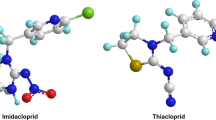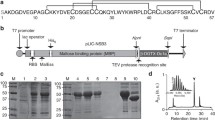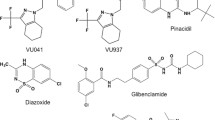Abstract
Nicotinic acetylcholine receptors (nAChRs) mediate fast synaptic transmission in the insect nervous system and are targets of a major group of insecticides, the neonicotinoids. Analyses of genome sequences have shown that nAChR gene families remain compact in diverse insect species, when compared to their mammalian counterparts. Thus, Drosophila melanogaster and Anopheles gambiae each possess 10 nAChR genes while Apis mellifera has 11. Although these are among the smallest nAChR gene families known, receptor diversity can be considerably increased by alternative splicing and mRNA A-to-I editing, thereby generating species-specific subunit isoforms. In addition, each insect possesses at least one highly divergent nAChR subunit. Species-specific subunit diversification may offer promising targets for future rational design of insecticides that act on particular pests while sparing beneficial insects. Electrophysiological studies on cultured Drosophila cholinergic neurons show partial agonist actions of the neonicotinoid imidacloprid and super-agonist actions of another neonicotinoid, clothianidin, on native nAChRs. Recombinant hybrid heteromeric nAChRs comprising Drosophila Dα2 and a vertebrate β2 subunit have been instructive in mimicking such actions of imidacloprid and clothianidin. Unitary conductance measurements on native nAChRs indicate that more frequent openings of the largest conductance state may offer an explanation for the superagonist actions of clothianidin.



Similar content being viewed by others
References
Aridon P, Marini C, Di Resta C, Brilli E, De Fusco M, Politi F, Parrini E, Manfredi I, Pisano T, Pruna D, Curia G, Cianchetti C, Pasqualetti M, Becchetti A, Guerrini R, Casari G (2006) Increased sensitivity of the neuronal nicotinic receptor alpha 2 subunit causes familial epilepsy with nocturnal wandering and ictal fear. Am J Hum Genet 79:342–350
Bass C, Lansdell SJ, Millar NS, Schroeder I, Turberg A, Field LM, Williamson MS (2006) Molecular characterisation of nicotinic acetylcholine receptor subunits from the cat flea, Ctenocephalides felis (Siphonaptera: Pulicidae). Insect Biochem Mol Biol 36:86–96
Bentley GN, Jones AK, Oliveros Parra WG, Agnew A (2004) ShAR1alpha and ShAR1beta: novel putative nicotinic acetylcholine receptor subunits from the platyhelminth blood fluke Schistosoma. Gene 329:27–38
Borges LS, Ferns M (2001) Agrin-induced phosphorylation of the acetylcholine receptor regulates cytoskeletal anchoring and clustering. J Cell Biol 153:1–12
Brown LA, Ihara M, Buckingham SD, Matsuda K, Sattelle DB (2006a) Neonicotinoid insecticides display partial and super agonist actions on native insect nicotinic acetylcholine receptors. J Neurochem 99:608–615
Brown LA, Jones AK, Buckingham SD, Mee CJ, Sattelle DB (2006b) Contributions from Caenorhabditis elegans functional genetics to antiparasitic drug target identification and validation: nicotinic acetylcholine receptors, a case study. Int J Parasitol 36:617–624
Corringer PJ, Le Novere N, Changeux JP (2000) Nicotinic receptors at the amino acid level. Annu Rev Pharmacol Toxicol 40:431–458
Deglise P, Grunewald B, Gauthier M (2002) The insecticide imidacloprid is a partial agonist of the nicotinic receptor of honeybee Kenyon cells. Neurosci Lett 321:13–16
Fayyazuddin A, Zaheer MA, Hiesinger PR, Bellen HJ (2006) The nicotinic acetylcholine receptor Dalpha7 is required for an escape behavior in Drosophila. PLoS Biol 4:e63
Gallowitsch-Puerta M, Tracey KJ (2005) Immunologic role of the cholinergic anti-inflammatory pathway and the nicotinic acetylcholine alpha 7 receptor. Ann NY Acad Sci 1062:209–219
Gehle VM, Walcott EC, Nishizaki T, Sumikawa K (1997) N-glycosylation at the conserved sites ensures the expression of properly folded functional ACh receptors. Brain Res Mol Brain Res 45:219–229
Gotti C, Zoli M, Clementi F (2006) Brain nicotinic acetylcholine receptors: native subtypes and their relevance. Trends Pharmacol Sci 27:482–491
Grauso M, Reenan RA, Culetto E, Sattelle DB (2002) Novel putative nicotinic acetylcholine receptor subunit genes, dalpha5, dalpha6 and dalpha7, in Drosophila melanogaster identify a new and highly conserved target of adenosine deaminase acting on RNA-mediated A-to-I pre-mRNA editing. Genetics 160:1519–1533
Green WN, Wanamaker CP (1997) The role of the cystine loop in acetylcholine receptor assembly. J Biol Chem 272:20945–20953
Guzman GR, Santiago J, Ricardo A, Marti-Arbona R, Rojas LV, Lasalde-Dominicci JA (2003) Tryptophan scanning mutagenesis in the alphaM3 transmembrane domain of the Torpedo californica acetylcholine receptor: functional and structural implications. Biochemistry 42:12243–12250
Hoopengardner B, Bhalla T, Staber C, Reenan R (2003) Nervous system targets of RNA editing identified by comparative genomics. Science 301:832–836
Hopfield JF, Tank DW, Greengard P, Huganir RL (1988) Functional modulation of the nicotinic acetylcholine receptor by tyrosine phosphorylation. Nature 336:677–680
Ihara M, Matsuda K, Otake M, Kuwamura M, Shimomura M, Komai K, Akamatsu M, Raymond V, Sattelle DB (2003) Diverse actions of neonicotinoids on chicken alpha7, alpha4beta2 and Drosophila-chicken SADbeta2 and ALSbeta2 hybrid nicotinic acetylcholine receptors expressed in Xenopus laevis oocytes. Neuropharmacology 45:133–144
Ihara M, Matsuda K, Shimomura M, Sattelle DB, Komai K (2004) Super agonist actions of clothianidin and related compounds on the SAD beta 2 nicotinic acetylcholine receptor expressed in Xenopus laevis oocytes. Biosci Biotechnol Biochem 68:761–763
Jones AK, Sattelle DB (2004) Functional genomics of the nicotinic acetylcholine receptor gene family of the nematode, Caenorhabditis elegans. Bioessays 26:39–49
Jones AK, Sattelle DB (2006) The cys-loop ligand-gated ion channel superfamily of the honeybee, Apis mellifera. Invert Neurosci 6:123–132
Jones AK, Elgar G, Sattelle DB (2003) The nicotinic acetylcholine receptor gene family of the pufferfish, Fugu rubripes. Genomics 82:441–451
Jones AK, Buckingham SD, Sattelle DB (2005a) Chemistry-to-gene screens in Caenorhabditis elegans. Nat Rev Drug Discov 4:321–330
Jones AK, Grauso M, Sattelle DB (2005b) The nicotinic acetylcholine receptor gene family of the malaria mosquito, Anopheles gambiae. Genomics 85:176–187
Jones AK, Marshall J, Blake AD, Buckingham SD, Darlison MG, Sattelle DB (2005c) Sgbeta1, a novel locust (Schistocerca gregaria) non-alpha nicotinic acetylcholine receptor-like subunit with homology to the Drosophila melanogaster Dbeta1 subunit. Invert Neurosci 5:147–155
Jones AK, Raymond-Delpech V, Thany SH, Gauthier M, Sattelle DB (2006) The nicotinic acetylcholine receptor gene family of the honey bee, Apis mellifera. Genome Res 16:1422–1430
Kao PN, Dwork AJ, Kaldany RR, Silver ML, Wideman J, Stein S, Karlin A (1984) Identification of the alpha subunit half-cystine specifically labeled by an affinity reagent for the acetylcholine receptor binding site. J Biol Chem 259:11662–11665
Lansdell SJ, Millar NS (2000) Cloning and heterologous expression of Dalpha4, a Drosophila neuronal nicotinic acetylcholine receptor subunit: identification of an alternative exon influencing the efficiency of subunit assembly. Neuropharmacology 39:2604–2614
Lansdell SJ, Millar NS (2002) Dbeta3, an atypical nicotinic acetylcholine receptor subunit from Drosophila: molecular cloning, heterologous expression and coassembly. J Neurochem 80:1009–1018
Liu Z, Williamson MS, Lansdell SJ, Denholm I, Han Z, Millar NS (2005) A nicotinic acetylcholine receptor mutation conferring target-site resistance to imidacloprid in Nilaparvata lugens (brown planthopper). Proc Natl Acad Sci USA 102:8420–8425
Liu Z, Williamson MS, Lansdell SJ, Han Z, Denholm I, Millar NS (2006) A nicotinic acetylcholine receptor mutation (Y151S) causes reduced agonist potency to a range of neonicotinoid insecticides. J Neurochem 99:1273–1281
Matsuda K, Buckingham SD, Freeman JC, Squire MD, Baylis HA, Sattelle DB (1998) Effects of the alpha subunit on imidacloprid sensitivity of recombinant nicotinic acetylcholine receptors. Br J Pharmacol 123:518–524
Matsuda K, Buckingham SD, Kleier D, Rauh JJ, Grauso M, Sattelle DB (2001) Neonicotinoids: insecticides acting on insect nicotinic acetylcholine receptors. Trends Pharmacol Sci 22:573–580
Matsuda K, Shimomura M, Ihara M, Akamatsu M, Sattelle DB (2005) Neonicotinoids show selective and diverse actions on their nicotinic receptor targets: electrophysiology, molecular biology, and receptor modeling studies. Biosci Biotechnol Biochem 69:1442–1452
Mencke N, Jeschke P (2002) Therapy and prevention of parasitic insects in veterinary medicine using imidacloprid. Curr Top Med Chem 2:701–715
Millar NS (2003) Assembly and subunit diversity of nicotinic acetylcholine receptors. Biochem Soc Trans 31:869–874
Mongan NP, Jones AK, Smith GR, Sansom MS, Sattelle DB (2002) Novel alpha7-like nicotinic acetylcholine receptor subunits in the nematode Caenorhabditis elegans. Protein Sci 11:1162–1171
Morgan NV, Brueton LA, Cox P, Greally MT, Tolmie J, Pasha S, Aligianis IA, van Bokhoven H, Marton T, Al-Gazali L, Morton JE, Oley C, Johnson CA, Trembath RC, Brunner HG, Maher ER (2006) Mutations in the embryonal subunit of the acetylcholine receptor (CHRNG) cause lethal and Escobar variants of multiple pterygium syndrome. Am J Hum Genet 79:390–395
Nagata K, Aistrup GL, Song JH, Narahashi T (1996) Subconductance-state currents generated by imidacloprid at the nicotinic acetylcholine receptor in PC 12 cells. Neuroreport 7:1025–1028
Nauen R, Denholm I (2005) Resistance of insect pests to neonicotinoid insecticides: current status and future prospects. Arch Insect Biochem Physiol 58:200–215
Nishizaki T (2003) N-glycosylation sites on the nicotinic ACh receptor subunits regulate receptor channel desensitization and conductance. Brain Res Mol Brain Res 114:172–176
Raymond-Delpech V, Matsuda K, Sattelle BM, Rauh JJ, Sattelle DB (2005) Ion channels: molecular targets of neuroactive insecticides. Invert Neurosci 5:119–133
Revah F, Bertrand D, Galzi JL, Devillers-Thiery A, Mulle C, Hussy N, Bertrand S, Ballivet M, Changeux JP (1991) Mutations in the channel domain alter desensitization of a neuronal nicotinic receptor. Nature 353:846–849
Rozycka A, Trzeciak WH (2003) Genetic basis of autosomal dominant nocturnal frontal lobe epilepsy. J Appl Genet 44:197–207
Rust MK (2005) Advances in the control of Ctenocephalides felis (cat flea) on cats and dogs. Trends Parasitol 21:232–236
Saragoza PA, Modir JG, Goel N, French KL, Li L, Nowak MW, Stitzel JA (2003) Identification of an alternatively processed nicotinic receptor alpha7 subunit RNA in mouse brain. Brain Res Mol Brain Res 117:15–26
Sattelle DB, Jones AK, Sattelle BM, Matsuda K, Reenan R, Biggin PC (2005) Edit, cut and paste in the nicotinic acetylcholine receptor gene family of Drosophila melanogaster. Bioessays 27:366–376
Seeburg PH (2002) A-to-I editing: new and old sites, functions and speculations. Neuron 35:17–20
Shimomura M, Okuda H, Matsuda K, Komai K, Akamatsu M, Sattelle DB (2002) Effects of mutations of a glutamine residue in loop D of the alpha7 nicotinic acetylcholine receptor on agonist profiles for neonicotinoid insecticides and related ligands. Br J Pharmacol 137:162–169
Shimomura M, Yokota M, Okumura M, Matsuda K, Akamatsu M, Sattelle DB, Komai K (2003) Combinatorial mutations in loops D and F strongly influence responses of the alpha7 nicotinic acetylcholine receptor to imidacloprid. Brain Res 991:71–77
Shimomura M, Yokota M, Matsuda K, Sattelle DB, Komai K (2004) Roles of loop C and the loop B–C interval of the nicotinic receptor alpha subunit in its selective interactions with imidacloprid in insects. Neurosci Lett 363:195–198
Sine SM, Engel AG (2006) Recent advances in Cys-loop receptor structure and function. Nature 440:448–455
Smit AB, Brejc K, Syed N, Sixma TK (2003) Structure and function of AChBP, homologue of the ligand-binding domain of the nicotinic acetylcholine receptor. Ann NY Acad Sci 998:81–92
Stetefeld J, Ruegg MA (2005) Structural and functional diversity generated by alternative mRNA splicing. Trends Biochem Sci 30:515–521
Tamamizu S, Lee Y, Hung B, McNamee MG, Lasalde-Dominicci JA (1999) Alteration in ion channel function of mouse nicotinic acetylcholine receptor by mutations in the M4 transmembrane domain. J Membr Biol 170:157–164
Thany SH, Crozatier M, Raymond-Delpech V, Gauthier M, Lenaers G (2005) Apisalpha2, apisalpha7–1 and apisalpha7–2: three new neuronal nicotinic acetylcholine receptor alpha-subunits in the honeybee brain. Gene 344:125–132
Tomizawa M, Casida JE (2005) Neonicotinoid insecticide toxicology: mechanisms of selective action. Annu Rev Pharmacol Toxicol 45:247–268
Author information
Authors and Affiliations
Corresponding author
Rights and permissions
About this article
Cite this article
Jones, A.K., Brown, L.A. & Sattelle, D.B. Insect nicotinic acetylcholine receptor gene families: from genetic model organism to vector, pest and beneficial species. Invert Neurosci 7, 67–73 (2007). https://doi.org/10.1007/s10158-006-0039-6
Received:
Accepted:
Published:
Issue Date:
DOI: https://doi.org/10.1007/s10158-006-0039-6




